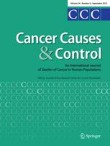Is mammographic density a marker of breast cancer phenotypes?:

Abstract
Purpose
To investigate the association between mammographic density (MD) phenotypes and both clinicopathologic features of breast cancer (BC) and tumor location.
Methods
MD was measured for 297 BC-affected females using qualitative (visual method) and quantitative (fully automated area-based method) approaches. Radiologists’ description, visible external markers, and surgical scar were used to establish the location of tumors. Binary logistic regression models were used to assess the association between MD phenotypes and BC clinicopathologic features.
Results
Categorical and numerical MD measures showed no association with clinicopathologic features of BC (
p > 0.05). Participants with higher BI-RADS scores [(51–75% glandular) and (> 75% glandular)] (
p < 0.001), and percent density (PD) categories [PD (21–49%) and PD ≥ 50%] (
p = 0.01) were more likely to have tumors emanating from dense areas. Additionally, tumors were commonly found in dense regions of the breast among patients with higher medians of PD (
p = 0.001), dense area (DA) (
p = 0.02), and lower medians of non-dense area (NDA) (
p < 0.001). Adjusted logistic regression models showed that high BI-RADS density (> 75% glandular) has an almost fivefold increased odds of tumors developing within dense areas (OR 4.99, 95% CI 0.93–25.9;
p = 0.05. PD (OR 1.02, 95% CI 1–1.03,
p = 0.002) and NDA (OR 0.99, 95% CI 0.991–0.997,
p < 0.001) had very small effect on tumor location. Compared to tumors within non-dense areas, tumors in dense areas tended to exhibit human epidermal growth factor receptor 2 positive (
p = 0.05) and carcinoma in situ (
p = 0.01) characteristics.
Conclusion
MD shows no significant association with clinicopathologic features of BC. However, BC was more likely to originate from dense tissue, with tumors in dense regions having human epidermal growth receptor 2 positive and carcinoma in situ characteristics.





Δεν υπάρχουν σχόλια:
Δημοσίευση σχολίου